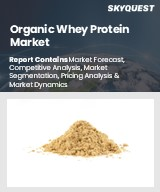
세계의 유기농 유청 단백질 시장 규모는 2023년 95억 달러로 평가되었으며, 2024년 102억 달러, 2032년까지 183억 달러에 이르고, 예측 기간(2025-2032년) 동안 CAGR 7.6%의 성장이 예측되고 있습니다.
세계의 유기농 유청 단백질 시장은 주로 건강과 웰빙에 대한 소비자의 관심이 높아짐에 따라 상당한 확대를 볼 수 있습니다. 유기농 제품에 대한 선호도 증가는 시장 성장을 뒷받침하고 있으며, 개인이 화학 물질을 함유하지 않는 깨끗한 라벨 보충제를 요구하는 경향이 커지고 있습니다. 이 동향은 피트니스 애호가와 운동 선수를 포함한 건강 지향 소비자들 사이에서 특히 두드러집니다. E-Commerce의 상승이 시장에 대한 접근을 확대하는 한편, 신흥국에서의 가처분 소득 증가와 유당 불내증에 대한 의식의 높아짐이, 소비자를 유기농이나 목초 사육의 유단백질원으로 향하게 했습니다. 막 여과 및 정밀 여과와 같은 기술의 진보는 제품의 순도와 영양 함량을 높이고 생물학적 활성 화합물의 보존을 가능하게합니다. 이러한 기술 혁신은 보다 고품질의 단백질 생산을 가능하게 하고, 건강 지향 소비자들에게 유기농 유청 단백질이 더욱 매력적이 되고 있습니다.
Global Organic Whey Protein Market size was valued at USD 9.5 Billion in 2023 poised to grow to between USD 10.2 Billion in 2024 to USD 18.3 Billion by 2032, growing at a CAGR of 7.6% in the forecast period (2025-2032).
The global organic whey protein market is witnessing considerable expansion, primarily driven by heightened consumer interest in health and wellness. A growing preference for organic products is propelling market growth, as individuals increasingly seek chemical-free and clean-label supplements. This trend is particularly pronounced among health-centric consumers, including fitness enthusiasts and athletes. The rise of e-commerce has expanded market accessibility, while increasing disposable incomes in emerging economies and heightened awareness of lactose intolerance have nudged consumers towards organic and grass-fed dairy protein sources. Technological advancements, such as membrane filtration and microfiltration, are enhancing product purity and nutritional content, allowing for the preservation of bioactive compounds. These innovations enable the production of higher-quality proteins, making organic whey protein more appealing to health-conscious consumers.
Top-down and bottom-up approaches were used to estimate and validate the size of the Global Organic Whey Protein market and to estimate the size of various other dependent submarkets. The research methodology used to estimate the market size includes the following details: The key players in the market were identified through secondary research, and their market shares in the respective regions were determined through primary and secondary research. This entire procedure includes the study of the annual and financial reports of the top market players and extensive interviews for key insights from industry leaders such as CEOs, VPs, directors, and marketing executives. All percentage shares split, and breakdowns were determined using secondary sources and verified through Primary sources. All possible parameters that affect the markets covered in this research study have been accounted for, viewed in extensive detail, verified through primary research, and analyzed to get the final quantitative and qualitative data.
Global Organic Whey Protein Market Segments Analysis
The global organic whey protein market is segmented based on type, application, end-user, and regions. In terms of type, the market is segmented into whey protein concentrate, hydrolyzed whey protein, whey protein isolate, and others. Based on application, market is segmented into nutraceutical and dietary supplements, food and beverages, personal care and cosmetics, and others. Based on end-user, the market is segmented into athletes, bodybuilder, health-conscious consumers and others. Based on region, the market is segmented into North America, Europe, Asia-Pacific, Latin America and the Middle East & Africa.
Driver of the Global Organic Whey Protein Market
The global surge in health consciousness among consumers is driving the demand for clean-label, high-protein products such as organic whey protein. Individuals increasingly prioritize health through fitness, weight management, and preventive healthcare, leading them to seek out organic protein options that align with their wellness goals. As nearly sixty percent of adults actively participate in various fitness activities, the preference for nutritious, organic food sources becomes more pronounced. This growing awareness of health and nutrition is steering consumers toward organic whey protein, positioning it as a preferred choice for those seeking to enhance their overall well-being.
Restraints in the Global Organic Whey Protein Market
The Global Organic Whey Protein market encounters significant challenges due to stringent agricultural practices, rigorous quality control, and certification standards that lead to elevated production costs for manufacturers. These increased expenses ultimately reflect in the pricing of organic whey protein, making it less attainable for consumers in price-sensitive segments. Consequently, the high costs can impede broader market adoption and pose competitive hurdles, as potential buyers may opt for more affordable alternatives. Thus, these financial constraints can limit the growth and expansion of the market, hindering its overall potential and accessibility to a wider audience.
Market Trends of the Global Organic Whey Protein Market
The Global Organic Whey Protein market is witnessing a significant trend driven by the escalating demand for clean-label nutrition among consumers. As health-conscious individuals increasingly favor products devoid of artificial additives, hormones, and GMOs, there is a surge in interest toward organic whey protein. This trend is further bolstered by a heightened focus on ingredient transparency and ethical sourcing, prompting brands to enhance their credibility through organic certification and traceability. Consequently, the market is evolving to meet these consumer expectations, fostering innovation and positioning organic whey protein as a preferred choice for those prioritizing health and nutrition.